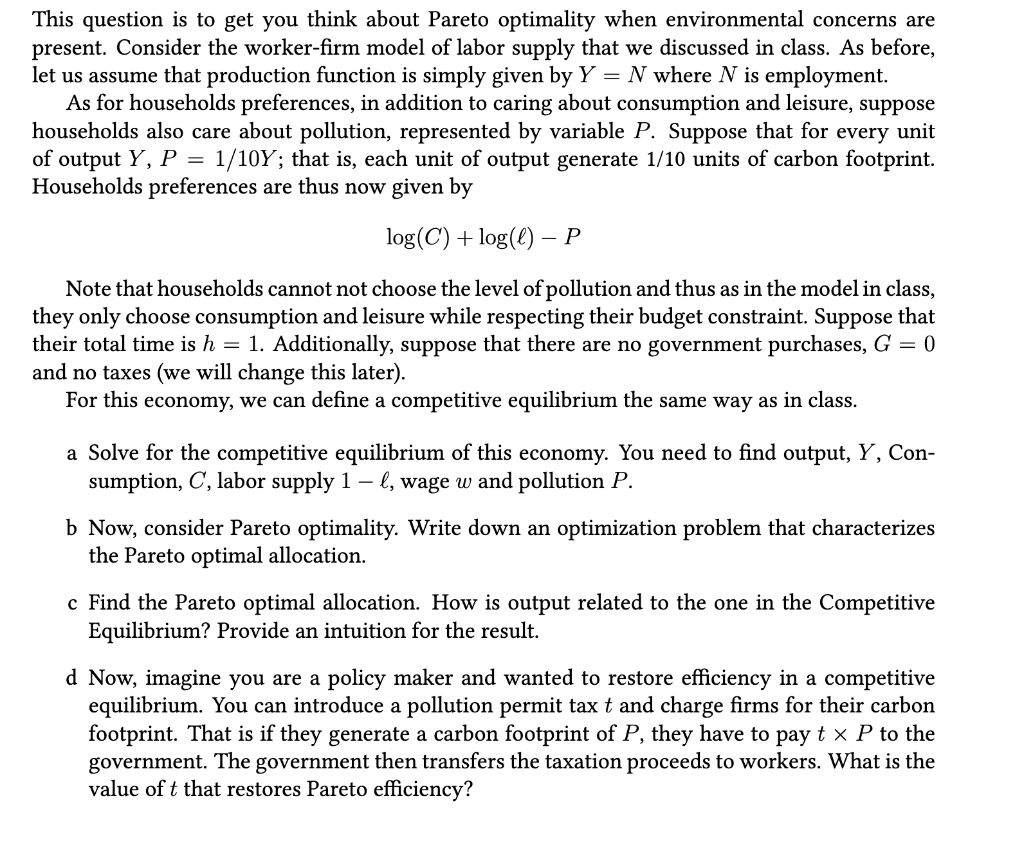
This question is to get you think about Pareto optimality when environmental concerns are present. Consider the worker-firm model of labor supply that we discussed in class. As before, let us assume that production function is simply given by Y=N where N is employment. As for households preferences, in addition to caring about consumption and leisure, suppose households also care about pollution, represented by variable P. Suppose that for every unit of output Y,P=1/10Y; that is, each unit of output generate 1/10 units of carbon footprint. Households preferences are thus now given by log(C)+log()P Note that households cannot not choose the level of pollution and thus as in the model in class, they only choose consumption and leisure while respecting their budget constraint. Suppose that their total time is h=1. Additionally, suppose that there are no government purchases, G=0 and no taxes (we will change this later). For this economy, we can define a competitive equilibrium the same way as in class. a Solve for the competitive equilibrium of this economy. You need to find output, Y, Consumption, C, labor supply 1, wage w and pollution P. b Now, consider Pareto optimality. Write down an optimization problem that characterizes the Pareto optimal allocation. c Find the Pareto optimal allocation. How is output related to the one in the Competitive Equilibrium? Provide an intuition for the result. d Now, imagine you are a policy maker and wanted to restore efficiency in a competitive equilibrium. You can introduce a pollution permit tax t and charge firms for their carbon footprint. That is if they generate a carbon footprint of P, they have to pay tP to the government. The government then transfers the taxation proceeds to workers. What is the value of t that restores Pareto efficiency? This question is to get you think about Pareto optimality when environmental concerns are present. Consider the worker-firm model of labor supply that we discussed in class. As before, let us assume that production function is simply given by Y=N where N is employment. As for households preferences, in addition to caring about consumption and leisure, suppose households also care about pollution, represented by variable P. Suppose that for every unit of output Y,P=1/10Y; that is, each unit of output generate 1/10 units of carbon footprint. Households preferences are thus now given by log(C)+log()P Note that households cannot not choose the level of pollution and thus as in the model in class, they only choose consumption and leisure while respecting their budget constraint. Suppose that their total time is h=1. Additionally, suppose that there are no government purchases, G=0 and no taxes (we will change this later). For this economy, we can define a competitive equilibrium the same way as in class. a Solve for the competitive equilibrium of this economy. You need to find output, Y, Consumption, C, labor supply 1, wage w and pollution P. b Now, consider Pareto optimality. Write down an optimization problem that characterizes the Pareto optimal allocation. c Find the Pareto optimal allocation. How is output related to the one in the Competitive Equilibrium? Provide an intuition for the result. d Now, imagine you are a policy maker and wanted to restore efficiency in a competitive equilibrium. You can introduce a pollution permit tax t and charge firms for their carbon footprint. That is if they generate a carbon footprint of P, they have to pay tP to the government. The government then transfers the taxation proceeds to workers. What is the value of t that restores Pareto efficiency







